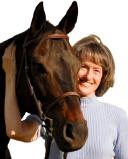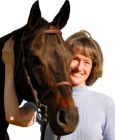Shyness
Sumo Wrestler Walks Into a Bar—er, Horse Show?
Why horses shy at unusual objects.
Posted August 7, 2021 Reviewed by Kaja Perina
Key points
- Prey brains are driven by fear.
- Human brains are protected by automatic categorical perception; horse brains are not.
- Horse brains have the perceptual range and hard wiring to notice new objects instantly and flee the risk.
- Horses can learn to overcome some of the skittishness of their prey brains, but it takes a lot of time and training.
It sounded like the beginning of a joke when I first heard that a sumo wrestler was scaring horses at the Tokyo Olympics. It turned out to be a statue, but the horses didn’t know that.
One of the trickiest things about riding horses is that they’re skittish. And we, with our human predator brains, can’t always anticipate what they’ll be skittish about. So, there you are cantering along on a 1400-pound beast who can leap 20 feet sideways in the blink of an eye, leaving you planted in the dirt. It's disconcerting not to know when or why they're going to bust that big move.
Prey brains are engineered to notice the slightest anomaly. Horses have not one, but two, noses—both of excellent quality. Their 340-degree range of vision helps them react to trouble early. Horizontal equine pupils are designed to notice tiny movements along the horizon while horses graze, and the visual area of equine brains contains neurons specialized for motion detection. To stay alive through millions of years of evolution, horses ran away from potential predators as quickly as possible. Their strength lay in the speed and agility that long legs and hard hooves provide. Why else would all that muscle and bone be perched so dangerously high in the air?
In addition, horse brains are wired directly from perception to movement, without the human brain’s way station of thought. This, too, aids survival. When you’re a prey animal, risky things might eat you for dinner. Better to run away first and ask questions later. All these features—double nose, range of view, horizontal pupils, specialized motion detection, and reactive hard wiring—cause our huge friends to spin and bolt or run backwards to get away from anything their prey brains deem potentially risky.
Now, let’s import that prey brain into a major Olympic show jumping competition. The course at Tokyo included 14 jumps, each about 5 feet high and up to 6 ½ feet wide. Course designers work hard to develop courses that are challenging for horse-and-human teams and visually appealing for the audience. Most important, though, these courses must also be relatively safe. Jumping is inherently dangerous, so there’s no need to add unnecessary objects that will naturally frighten the equine brain. In addition, each event should build confidence in the horse's mind, not erode it.
The sumo statue sat next to the tenth jump on course, with horses approaching it from behind. They rounded a corner to see a very unusual crouching predator with arms outstretched. Worse, the predator was hunkering below the height of the jump, as if ready to bite the horse’s belly as he soared over the rails. Riders claim the statue was visually realistic, and when horses are galloping toward a big jump, their excellent senses of smell are impaired by wind. They wouldn’t have accurate information as to whether this odd being smelled like a person, but it sure looked like one. All the horses could detect was an enormous crouching human predator, set to spring forward or upward at any moment.
What prey brain could ignore that? I would argue: None. It’s true that some of the horses did not visibly spook from the statue. There’s a reason for that—I’m getting there—but it’s also true that riders on site saw and felt many horses shy away, violently at times.
In addition to their wide range of perception and reactive hard wiring, horse brains process objects in a very different way than human brains do. Our noggins use an automatic process called categorical perception to group similar objects together. Once we know the common features of the group, our brains do not have to interpret each feature every time we are faced with a new instance of the object.
Statues, for example, have common features: they are not real, they cannot move, they look like the animals or humans they represent, they have no animal smell, and they tend to be large and heavy. Using the features common to the category of statues, human brains assume that each instance will follow the same basic rules. Is it a statue? Yep. OK, then no worries: it can’t move or attack. This process of human categorical perception is completely automatic: we are not aware of its existence, do not feel its mental operation, and can not stop it from occurring. Most people have trouble understanding it even after it's been explained.
Here’s the rub: Horse brains do not have categorical perception. To a horse, every new instance of a group is a brand new object. Nothing is known about it. Not only is each statue processed separately, but even each view of one statue requires independent handling by the prey brain. Riders often become frustrated with young horses who have passed an object many times but suddenly shy when approaching it from a new angle. To the human brain, it’s the same object. Risk has already been assessed and denied. To the equine brain, it’s a brand new object with a brand new potential for risk.
So why didn’t all the Tokyo show jumpers shy from the sumo wrestler? Because of differences in their backgrounds, training, and genetics. Horses can be taught to accept multiple views of new objects with relative calmness; it just takes time and good training. Their brains are still reacting internally, but their external behavior has been altered. Horses who are older, more experienced, and more trusting of their riders are less likely to display outward fear of a new object.
Eventually, the sumo wrestler statue was removed from the Olympic jumping course, and we can only hope that course designers will abandon such ideas in the future. The physical and mental health of the world’s finest horse-and-human teams deserve as much. Any self-respecting prey animal is going to dislike a large crouching predator with arms stretching out toward his belly.
Now, about that wrestler who walked into a bar…




